Downscaling of GRACE-Derived Groundwater Storage Based on the Random Forest Model
Abstract
1. Introduction
2. Materials and Methods
2.1. Study Area
2.2. Data Source and Processing
2.2.1. GRACE TWS
2.2.2. TRMM Precipitation
2.2.3. GLEAM Evaporation
2.2.4. GLDAS Data
2.2.5. Ground-Based Measurements
2.3. Model Design
2.3.1. Random Forest Model
2.3.2. Support Vector Machine Model
2.3.3. Artificial Neural Network
2.3.4. Multiple Linear Regression
2.3.5. Downscaling Model Design
- (1)
- First, the six hydrological variables during January, 2003 to July, 2016 are resampled to 1°. Aggregate 0.25° precipitation, evapotranspiration, runoff, soil moisture, snow water equivalent, and canopy water monthly average value from 0.25° to 1° by pixel averaging, respectively. Subsequently, established the random forest model between TWS and six hydrological variables at a spatial resolution of 1°.
- (2)
- Secondly, the GRACE-derived TWS data subtracted the TWS of the RF model simulation in step (1) and then calculated the residual distribution of TWS at a spatial resolution of 1°, after which residual at 1° model is interpolated to 0.25° by cubic spline function [62].
- (3)
- Thirdly, the established RF model is applied to the hydrological variables at a spatial resolution of 0.25° to obtain the estimated 0.25° TWS of the RF model. Afterwards, the estimated TWS at 0.25° is added to the residual at 0.25° to obtain the monthly TWS data with a spatial resolution of 0.25° after a residual correction.
- (4)
- Finally, we might obtain the downscaling GWS by deducting soil moisture, snow water equivalent, and canopy water from GLDAS NOAH model with a spatial resolution of 0.25° from downscaling TWS. Subsequently, we verified the result with the measured water level data and the downscaling GWS.
2.4. Data Comparison and Error Analysis
2.4.1. Correlation Coefficient (R)
2.4.2. Root Mean Squared Error (RMSE)
2.4.3. Nash-Sutcliffe Efficiency Coefficient (NSE)
2.4.4. Mean Absolute Error (MAE)
2.5. Significance Test
3. Results
3.1. Accuracy Estimation of Random Forest Model
3.2. Time Series and Spatial Accuracy
3.3. Testing and Spatial Accuracy
4. Discussion
- (1)
- Syed et al. [12] pointed out that the zonal average indicates that precipitation in the tropics dominates the TWSC, evapotranspiration is the most effective in the mid-latitudes, and snowmelt runoff is the main dissipation flux in the high latitudes. Therefore, in subsequent experiments, according to the latitude of the study area, remote sensing products with higher precision and finer resolution can be selected for research, and the impact of local economic and demographic conditions on water reserves needs to be properly considered.
- (2)
- From the global perspective, it can be divided into arid regions, semi-arid regions, and humid regions. According to the different characteristics of the study area, other variables, such as temperature, NDVI, DEM, and so on, can be appropriately added.
- (3)
- For regional scale research, we can select higher resolution remote sensing products to meet the requirements of regional water managers.
5. Conclusions
Author Contributions
Funding
Acknowledgments
Conflicts of Interest
References
- Rodell, M.; Velicogna, I.; Famiglietti, J.S. Satellite-based estimates of groundwater depletion in India. Nature 2009, 460, 999. [Google Scholar] [CrossRef] [PubMed]
- Wang, Y. The Evaluation of Environmental Quality of Groundwater in Inland Plains—A Study on Yanqi County in Xinjiang. Master’s Thesis, Xinjiang Agricultural University, Urumqi, China, 2010. [Google Scholar]
- Famiglietti, J.S.; Lo, M.; Ho, S.L.; Bethune, J.; Anderson, K.J.; Syed, T.H.; Swenson, S.C.; de Linage, C.R.; Rodell, M. Satellites measure recent rates of groundwater depletion in California’s Central Valley. Geophys. Res. Lett. 2011, 38. [Google Scholar] [CrossRef]
- Long, D.; Chen, X.; Scanlon, B.R.; Wada, Y.; Hong, Y.; Singh, V.P.; Chen, Y.; Wang, C.; Han, Z.; Yang, W. Have GRACE satellites overestimated groundwater depletion in the Northwest India Aquifer? Sci. Rep. 2016, 6, 24398. [Google Scholar] [CrossRef] [PubMed]
- Ye, S.H.; Huang, C. Space technique monitoring and prediction of ground water chinges. Prog. Geophys. 2007, 4, 1030–1034. (In Chinese) [Google Scholar]
- Ramilliena, G.; Frapparta, F.; Cazenavea, A.; Güntnerb, A. Time variations of land water storage from an inversion of 2 years of GRACE Geoids. Erath Planet. Sci. Lett. 2005, 235, 283–301. [Google Scholar] [CrossRef]
- Castellazzi, P.; Longuevergne, L.; Martel, R.; Rivera, A.; Brouard, C.; Chaussard, E. Quantitative mapping of groundwater depletion at the water management scale using a combined GRACE/InSAR approach. Remote Sens. Environ. 2018, 205, 408–418. [Google Scholar] [CrossRef]
- Davis, J.L.; Elósegui, P.; Mitrovica, J.X. Climate-driven deformation of the solid Earth from GRACE and GPS. Geophys. Res. Lett. 2004, 31, 357–370. [Google Scholar] [CrossRef]
- Yeh, P.J.F.; Swenson, S.C.; Famiglietti, J.S.; Rodell, M. Remote sensing of groundwater storage changes in Illinois using the Gravity Recovery and Climate Experiment (GRACE). Water Resour. Res. 2006, 42. [Google Scholar] [CrossRef]
- Feng, W.; Zhong, M.; Lemoine, J.; Biancale, R.; Hsu, H.; Xia, J. Evaluation of groundwater depletion in North China using the Gravity Recovery and Climate Experiment (GRACE) data and ground-based measurements. Water Resour. Res. 2013, 49, 2110–2118. [Google Scholar] [CrossRef]
- Rodell, M.; Chen, J.; Kato, H.; Famiglietti, J.S.; Nigro, J.; Wilson, C.R. Estimating groundwater storage changes in the Mississippi River basin (USA) using GRACE. Hydrogeol. J. 2007, 15, 159–166. [Google Scholar] [CrossRef]
- Syed, T.H.; Famiglietti, J.S.; Rodell, M.; Chen, J.; Wilson, C.R. Analysis of terrestrial water storage changes from GRACE and GLDAS. Water Resour. Res. 2008, 44. [Google Scholar] [CrossRef]
- Velicogna, I.; Wahr, J. Greenland mass balance from GRACE. Geophys. Res. Lett. 2005, 32. [Google Scholar] [CrossRef]
- Frappart, F.; Papa, F.; Famiglietti, J.S.; Prigent, C.; Rossow, W.B.; Seyler, F. Interannual variations of river water storage from a multiple satellite approach: A case study for the Rio Negro River basin. J. Geophys. Res. Atmos. 2008, 113. [Google Scholar] [CrossRef]
- Zhong, M.; Duan, J.; Xu, H.; Pen, P.; Yan, H.; Zhu, Y. Satellite gravity observation was used to study the change trend of medium and long space scale of China’s land water in recent 5 years. Chin. Sci. Bull. 2009, 54, 1290–1294. (In Chinese) [Google Scholar]
- Long, D.; Yang, Y.; Wada, Y.; Hong, Y.; Liang, W.; Chen, Y. Deriving scaling factors using a global hydrological model to restore GRACE total water storage changes for China’s Yangtze River Basin. Remote Sens. Environ. 2015, 168, 177–193. [Google Scholar] [CrossRef]
- Rodell, M.; Famiglietti, J.S.; Wiese, D.N.; Reager, J.T.; Beaudoing, H.K.; Landerer, F.W.; Lo, M.H. Emerging trends in global freshwater availability (vol 557, pg 651, 2018). Nature 2019, 565, E7. [Google Scholar] [CrossRef]
- Swenson, S.; Wahr, J.; Milly, P.C.D. Estimated accuracies of regional water storage variations inferred from the Gravity Recovery and Climate Experiment (GRACE). Water Resour. Res. 2003, 39, 1121–1134. [Google Scholar] [CrossRef]
- Richey, A.S.; Thomas, B.F.; Lo, M.; Reager, J.T.; Famiglietti, J.S.; Voss, K.; Swenson, S.; Rodell, M. Quantifying renewable groundwater stress with GRACE. Water Resour. Res. 2015, 52, 4184–4187. [Google Scholar] [CrossRef]
- Feng, W.; Wang, C.; Mu, D.; Zhong, M.; Zhong, Y.; Xu, H. Groundwater storage variations in the North China Plain from GRACE with spatial constraints. Chin. J. Geophys. 2017, 60, 1630–1642. (In Chinese) [Google Scholar]
- Ran, Q.; Pan, Y.; Wang, Y.R.; Chen, L.H.; Xu, H.L. Estimation of annual groundwater exploitation in Haihe River Basin by use of GRACE satellite data. Adv. Sci. Technol. Water Res. 2013, 33, 42–46. (In Chinese) [Google Scholar]
- Scanlon, B.R.; Longuevergne, L.; Long, D. Ground referencing GRACE satellite estimates of groundwater storage changes in the California Central Valley, USA. Water Resour. Res. 2012, 48, W04520. [Google Scholar] [CrossRef]
- Alley, W.M.; Konikow, L.F. Bringing GRACE Down to Earth. Ground Water 2015, 53, 826–829. [Google Scholar] [CrossRef] [PubMed]
- Miro, M.E.; Famiglietti, J.S. Downscaling GRACE Remote Sensing Datasets to High-Resolution Groundwater Storage Change Maps of California’s Central Valley. Remote Sens. 2018, 10, 143. [Google Scholar] [CrossRef]
- Liu, C.M.; Liu, W.B.; Fu, G.B.; OuYang, R.L. A discussion of some aspects of statistical downscaling in climate impacts assessment. Adv. Water Sci. 2012, 23, 427–437. (In Chinese) [Google Scholar]
- Zhang, M.Y.; Peng, D.Z.; Hu, L.J. Research Progress on Statistical Downscaling Methods. South-to-North South-to-North Water Transf. Water Sci. Technol. 2013, 11, 118–122. (In Chinese) [Google Scholar]
- Liu, Y.H.; Guo, W.D.; Feng, J.M.; Zhang, K.X. A Summary of Methods for Statistical Downscaling of Meteorological Data. Adv. Earth Sci. 2011, 26, 837–847. (In Chinese) [Google Scholar]
- Ning, S.W.; Ishidaira, H.; Wang, J. Statistical downscaling of GRACE-derived terrestrial water storage using satellite and GLDAS products. J. Jpn. Soc. Civ. Eng. 2014, 70, 133–138. [Google Scholar] [CrossRef]
- Yin, W.; Hu, L.; Zhang, M.; Wang, J.; Han, S. Statistical Downscaling of GRACE-Derived Groundwater Storage Using ET Data in the North China Plain. J. Geophys. Res. Atmos. 2018, 123, 5973–5987. [Google Scholar] [CrossRef]
- Seyoum, W.M.; Kwon, D.; Milewski, A.M. Downscaling GRACE TWSA Data into High-Resolution Groundwater Level Anomaly Using Machine Learning-Based Models in a Glacial Aquifer System. Remote Sens. 2019, 11, 824. [Google Scholar] [CrossRef]
- Sun, A.Y. Predicting groundwater level changes using GRACE data. Water Resour. Res. 2013, 49, 5900–5912. [Google Scholar] [CrossRef]
- Chen, S.; She, D.; Zhang, L.; Guo, M.; Liu, X. Spatial Downscaling Methods of Soil Moisture Based on Multisource Remote Sensing Data and Its Application. Water-Sui. 2019, 11, 1401. [Google Scholar] [CrossRef]
- Li, W.; Ni, L.; Li, Z.; Duan, S.; Wu, H. Evaluation of Machine Learning Algorithms in Spatial Downscaling of MODIS Land Surface Temperature. IEEE J. Sel. Top. Appl. Earth. Obs. Remote. Sens. 2019, 12, 2299–2307. [Google Scholar] [CrossRef]
- Shi, Y.; Song, L.; Xia, Z.; Lin, Y.; Myneni, R.B.; Choi, S.; Wang, L.; Ni, X.; Lao, C.; Yang, F. Mapping Annual Precipitation across Mainland China in the Period 2001–2010 from TRMM3B43 Product Using Spatial Downscaling Approach. Remote Sens. 2015, 7, 5849–5878. [Google Scholar] [CrossRef]
- Li, B.; Rodell, M.; Zaitchik, B.F.; Reichle, R.H.; Koster, R.D.; van Dam, T.M. Assimilation of GRACE terrestrial water storage into a land surface model: Evaluation and potential value for drought monitoring in western and central Europe. J. Hydrol. 2012, 446, 103–115. [Google Scholar] [CrossRef]
- Schmidt, R.; Schwintzer, P.; Flechtner, F.; Reigber, C.; Guntner, A.; Doll, P.; Ramillien, G.; Cazenave, A.; Petrovic, S.; Jochmann, H.; et al. GRACE observations of changes in continental water storage. Glob. Planet. Chang. 2006, 50, 112–126. [Google Scholar] [CrossRef]
- Yang, P.; Xia, J.; Zhan, C.; Wang, T. Reconstruction of terrestrial water storage anomalies in Northwest China during 1948–2002 using GRACE and GLDAS products. Hydrol. Res. 2018, 49, 1594–1607. [Google Scholar] [CrossRef]
- Breiman, L. Random Forest. Mach. Learn. 2001, 45, 5–32. [Google Scholar] [CrossRef]
- Vapnik, V.N. Statistical Learning Theory; Wiley: New York, NY, USA, 1998. [Google Scholar]
- Ghorbani, M.A.; Khatibi, R.; Hosseini, B.; Bilgili, M. Relative importance of parameters affecting wind speed prediction using artificial neural networks. Theor. Appl. Climatol. 2013, 114, 107–114. [Google Scholar] [CrossRef]
- Wang, J.; Zhang, J.M.; Ning, S.W.; Wang, H. Downscaling Analysis of GRACE Terrestrial Water Storage Changes in Yunnan Province. Water Res. Power 2018, 36, 1–5. (In Chinese) [Google Scholar]
- Wang, S.Q.; Song, X.F.; Wang, Q.X.; Xiao, Q.G.; Liu, C.M. Dynamic Features of Shallow Groundwater in North China Plain. Acta Geogr. Sin. 2008, 63, 435–445. (In Chinese) [Google Scholar]
- Cao, G.; Scanlon, B.R.; Han, D.; Zheng, C. Impacts of thicken in gun saturated zone on groundwater recharge in the North China Plain. J. Hydrol. 2016, 537, 260–270. [Google Scholar] [CrossRef]
- Wang, S.; Shao, J.; Song, X.; Zhang, Y.; Huo, Z.; Zhou, X. Application of MODFLOW and geographic information system to groundwater flow simulation in North China Plain. China. Environ. Geol. 2008, 55, 1449–1462. [Google Scholar] [CrossRef]
- Guo, H.; Zhang, Z.; Cheng, G.; Li, W.; Li, T.; Jiao, J.J. Groundwater-derived land subsidence in the North China Plain. Environ. Earth Sci. 2015, 74, 1415–1427. [Google Scholar] [CrossRef]
- Feng, W. GRAMAT: a comprehensive Matlab toolbox for estimating global mass variations from GRACE satellite data. Earth Sci. Inform. 2019, 12, 389–404. [Google Scholar] [CrossRef]
- Thomas, A.C.; Reager, J.T.; Famiglietti, J.S.; Rodell, M. A grace-based water storage deficit approach for hydrological drought characterization. Geophys. Res. Lett. 2014, 41, 1537–1545. [Google Scholar] [CrossRef]
- Wang, D.; Zhang, G. Groundwater Ensure Capacity Spatial-temporal Characteristics and Mechanism in Main Grain Producing. Acta Geoscientica Sinica. 2017, 38, 47–50. (In Chinese) [Google Scholar]
- Landerer, F.W.; Swenson, S.C. Accuracy of scaled GRACE terrestrial water storage estimates. Water Resour. Res. 2012, 48, W04531. [Google Scholar] [CrossRef]
- Wahr, J.; Molenaar, M.; Bryan, F. Time variability of the Earth’s gravity field: Hydrological and oceanic effects and their possible detection using GRACE. J. Geophys. Res. Solid Earth 1998, 103, 30205–30229. [Google Scholar] [CrossRef]
- Seyoum, W.M.; Milewski, A.M. Improved methods for estimating local terrestrial water dynamics from grace in the northern high plains. Adv. Water Resour. Res. 2017, 110, 279–290. [Google Scholar] [CrossRef]
- Kummerow, C.; Simpson, J.; Thiele, O.; Barnes, W.; Chang, A.; Stocker, E.; Adler, R.F.; Hou, A.; Kakar, R.; Wentz, F.; et al. The status of the Tropical Rainfall Measuring Mission (TRMM) after two years in orbit. J. Appl. Meteorol. 2000, 39, 1965–1982. [Google Scholar] [CrossRef]
- Sciences Data and Information Services Center (GES DISC). TRMM_3B43: TRMM (TMPA/3B43) Rainfall Estimate L3 1 Month 0.25 Degree × 0.25 Degree V7. Available online: https://disc.gsfc.nasa.gov/datasets/TRMM_3B43_7/summary?keywords=TRMM (accessed on 24 July 2019).
- Miralles, D.G.; Holmes, T.R.H.; Jeu, R.A.M. Global land-surface evaporation estimated from satellite-based observations. Hydrol. Earth Syst. Sci. 2010, 7, 8479–8519. [Google Scholar] [CrossRef]
- Martens, B.; Miralles, D.G.; Lievens, H.; van der Schalie, R.; de Jeu, R.A.M.; Fernandez-Prieto, D.; Beck, H.E.; Dorigo, W.; Verhoest, N. GLEAM v3: Satellite-based land evaporation and root-zone soil moisture. Geosci. Model Dev. 2017, 10, 1903–1925. [Google Scholar] [CrossRef]
- Global Land Evaporation Amsterdam Model (GLEAM). Version 3.3a Datasets. Available online: https://www.gleam.eu (accessed on 24 May 2019).
- Rodell, M.; Houser, P.R.; Jambor, U.; Gottschalck, J.; Mitchell, K.; Meng, C.J. The global land data assimilation system. Bull. Am. Meteorol. Soc. 2004, 85, 381–394. [Google Scholar] [CrossRef]
- Global Land Data Assimilation Systems (GLDAS). Goddard Earth Sciences Data and Information Services Center (GES DISC). Available online: https://disc.gsfc.nasa.gov/datasets (accessed on 24 July 2019).
- Jing, W.; Yang, Y.; Yue, X.; Zhao, X. A Comparison of Different Regression Algorithms for Downscaling Monthly Satellite-Based Precipitation over North China. Remote Sens. 2016, 8, 835. [Google Scholar] [CrossRef]
- Junwei, H.; Shanyou, Z.; Guixin, Z. Downscaling land surface temperature based on random forest algorithm. Remote Sens. Land Res. 2018, 30, 78–86. [Google Scholar]
- Nie, N.; Zhang, W.C.; Zhang, Z.J.; Guo, H.D.; Ishwaran, N. Reconstructed terrestrial water storage change (ΔTWS) from 1948 to 2012 over the Amazon Basin with the latest GRACE and GLDAS products. Water Resour. Manag. 2016, 30, 279–294. [Google Scholar] [CrossRef]
- Guler, H.G.; Baykal, C.; Ozyurt, G.; Kisacik, D. Performance of Statistical Temporal Downscaling Techniques of Wind Speed Data over Aegean Sea; European Geosciences Union General Assembly: Vienna, Austria, 2016; Volume 18. [Google Scholar]
- Rowlands, D.D.; Luthcke, S.B.; Klosko, S.M.; Lemoine, F.; Chinn, D.S.; McCarthy, J.J.; Cox, C.M.; Anderson, O.B. Resolving mass flux at high spatial and temporal resolution using GRACE intersatellite measurements. Geophys. Res. Lett. 2005, 32. [Google Scholar] [CrossRef]
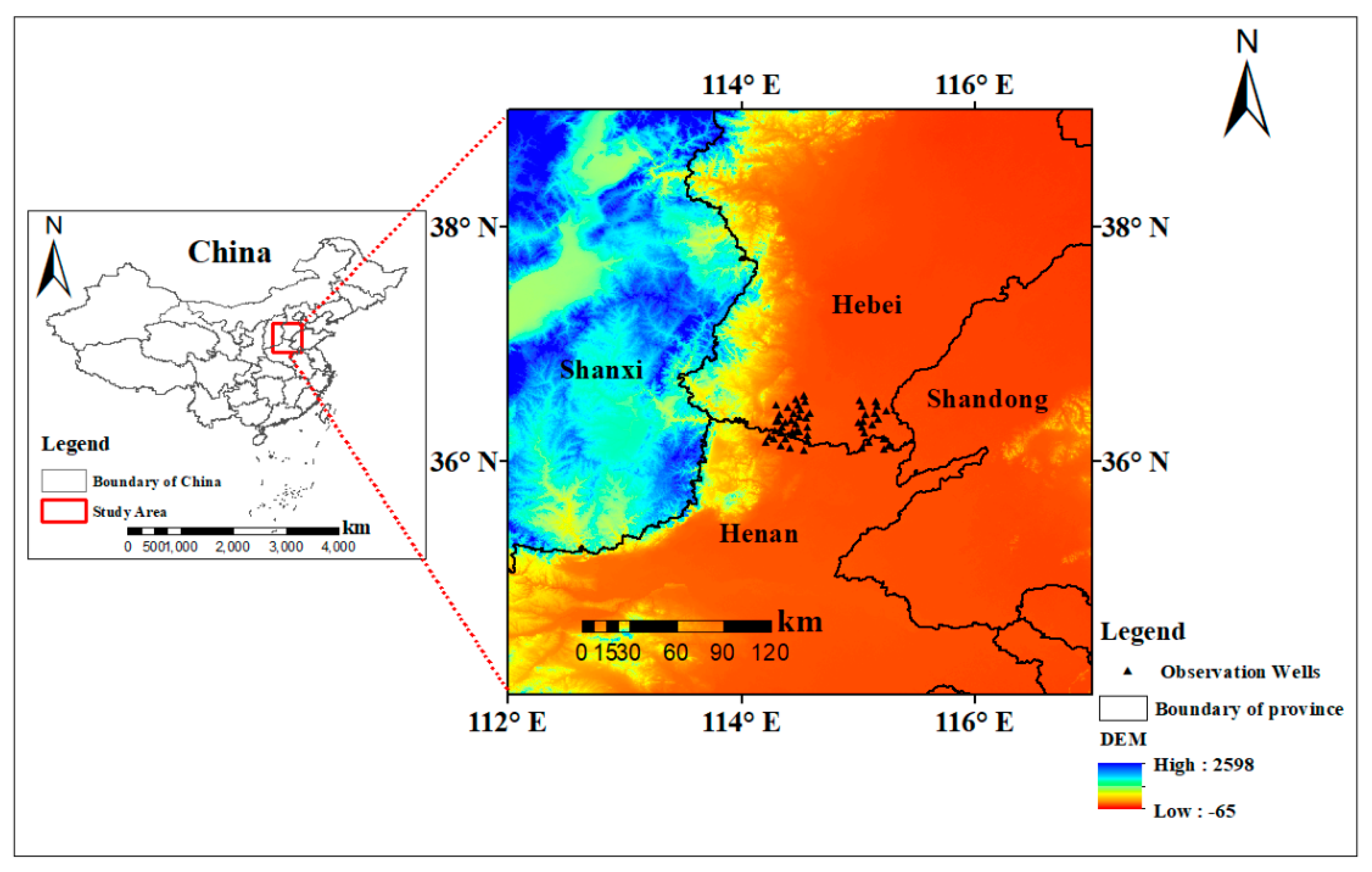
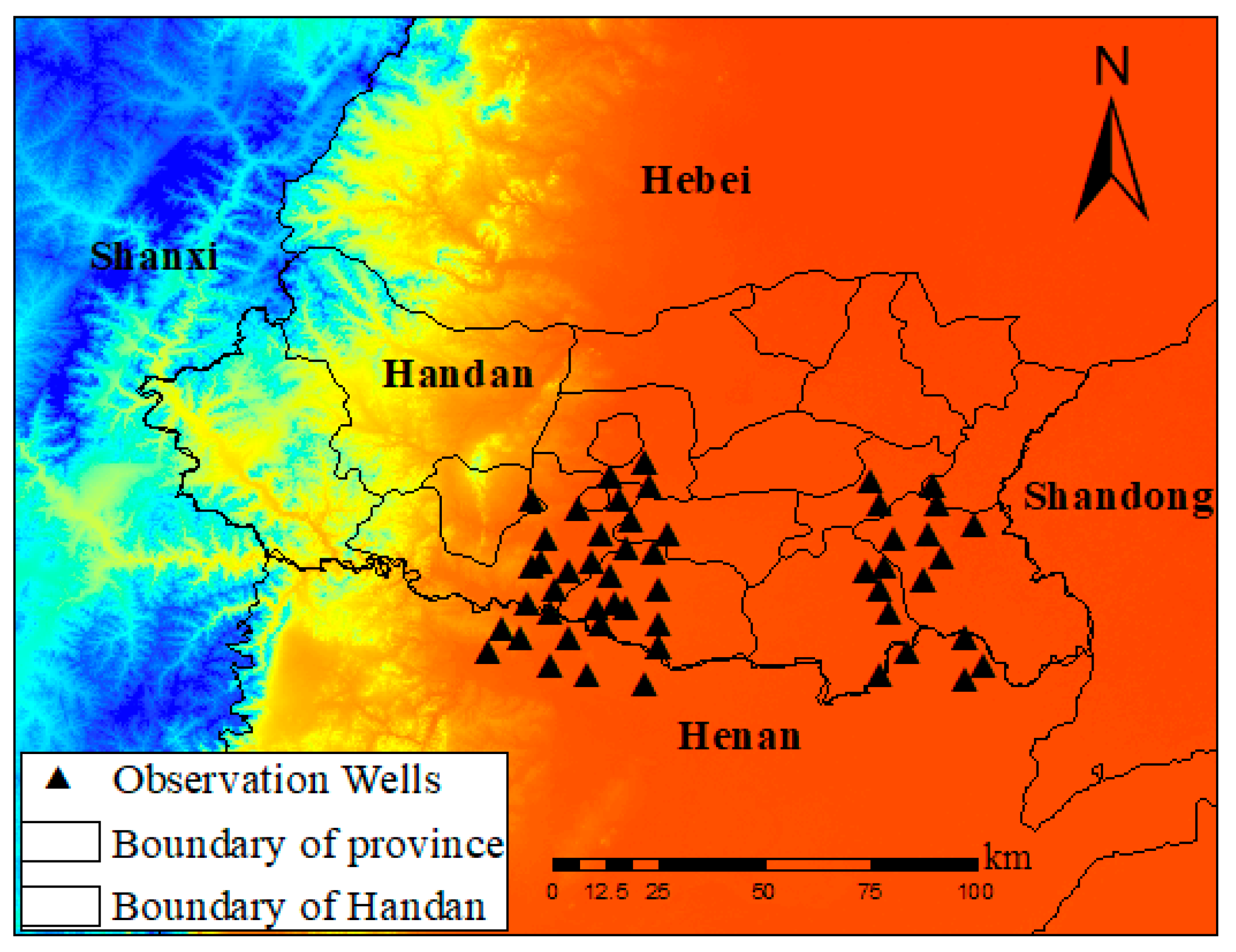
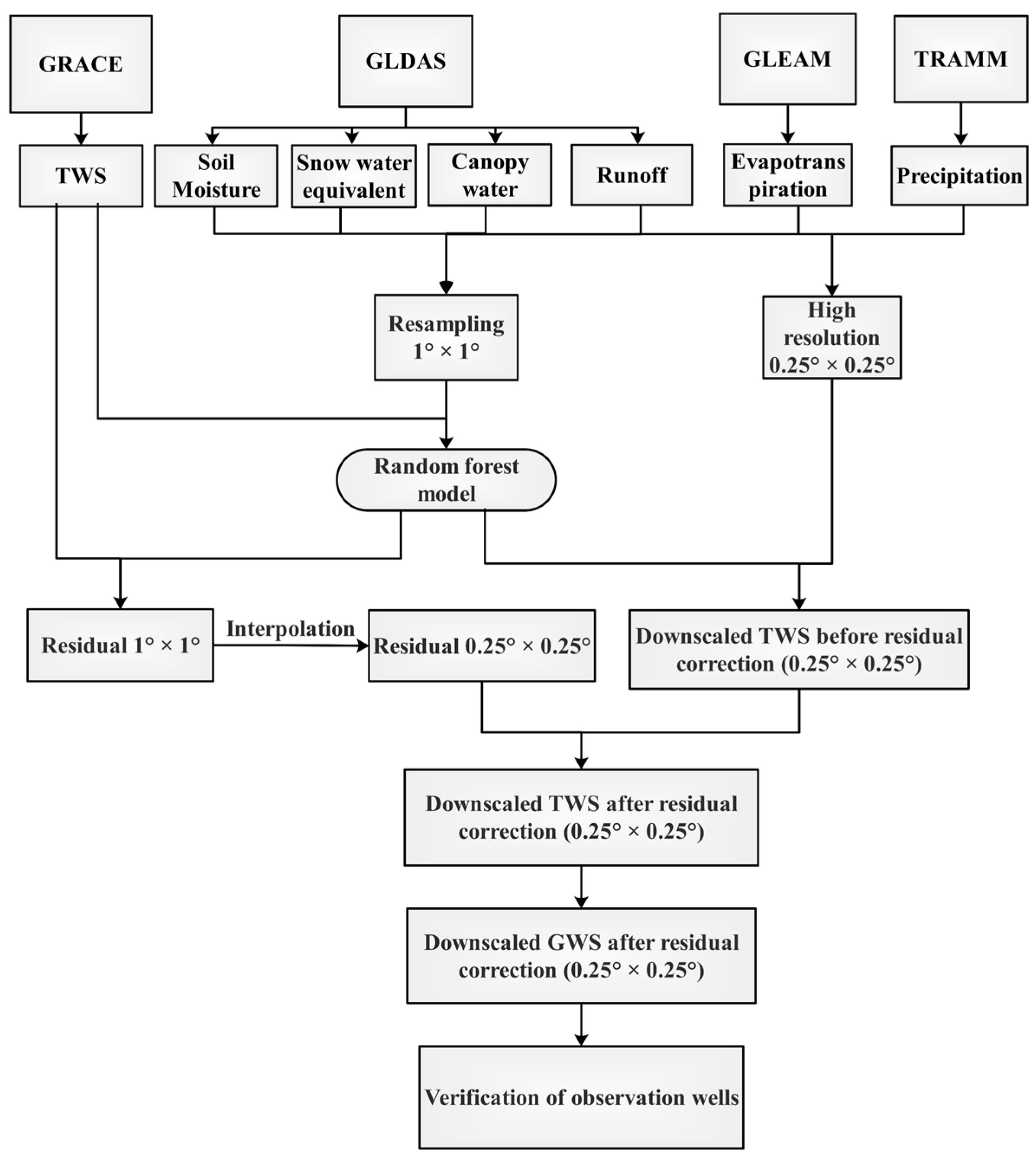
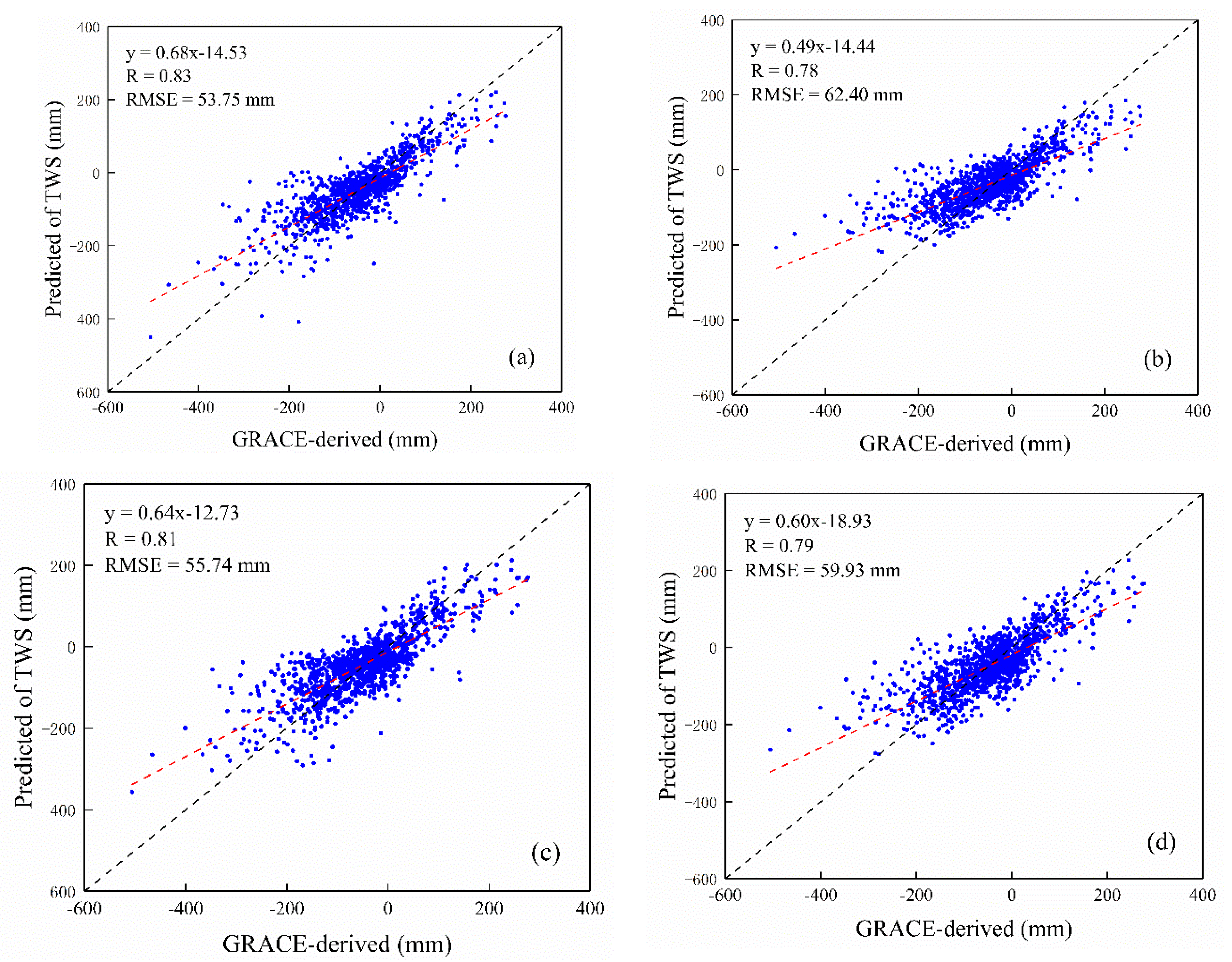
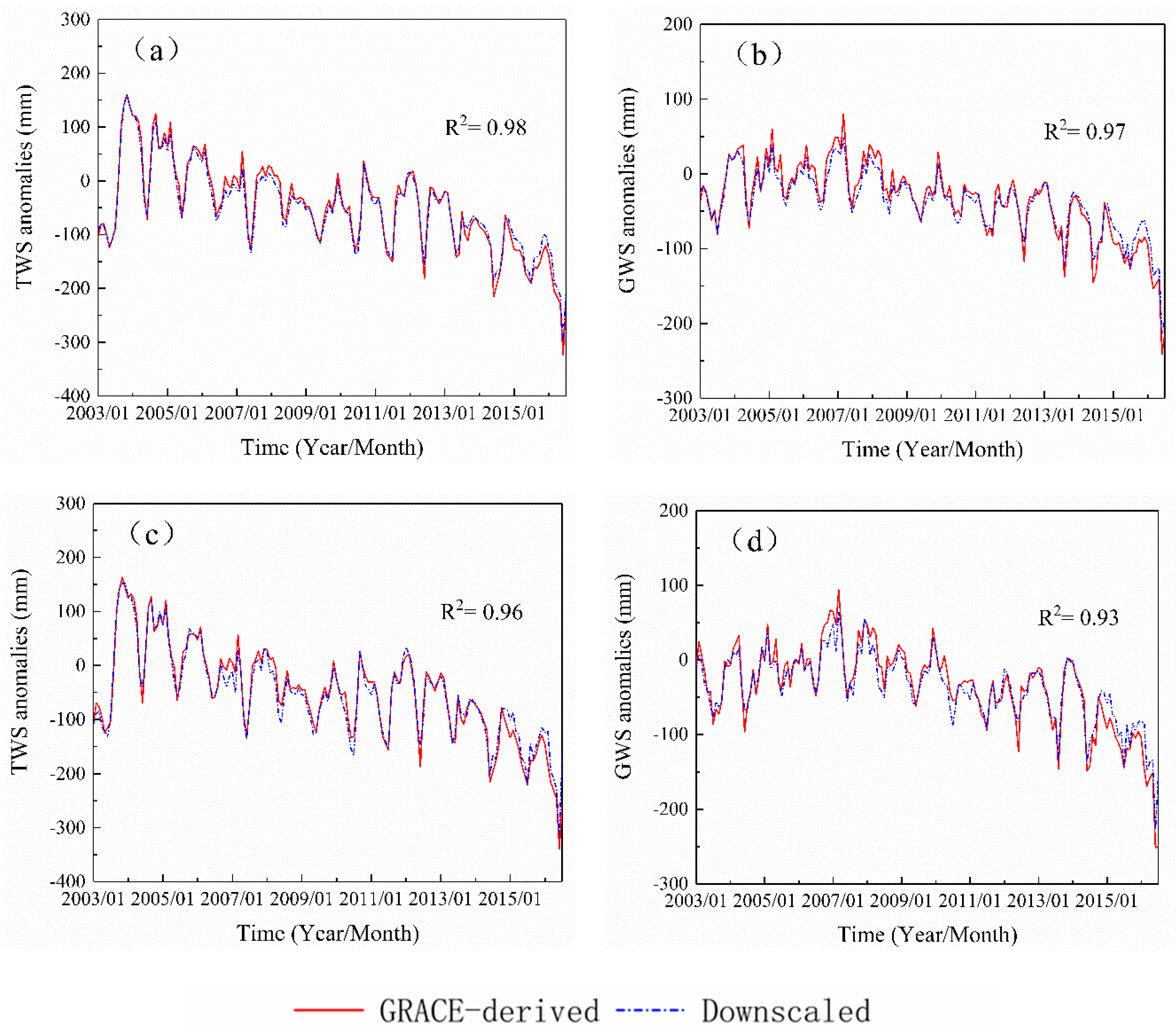
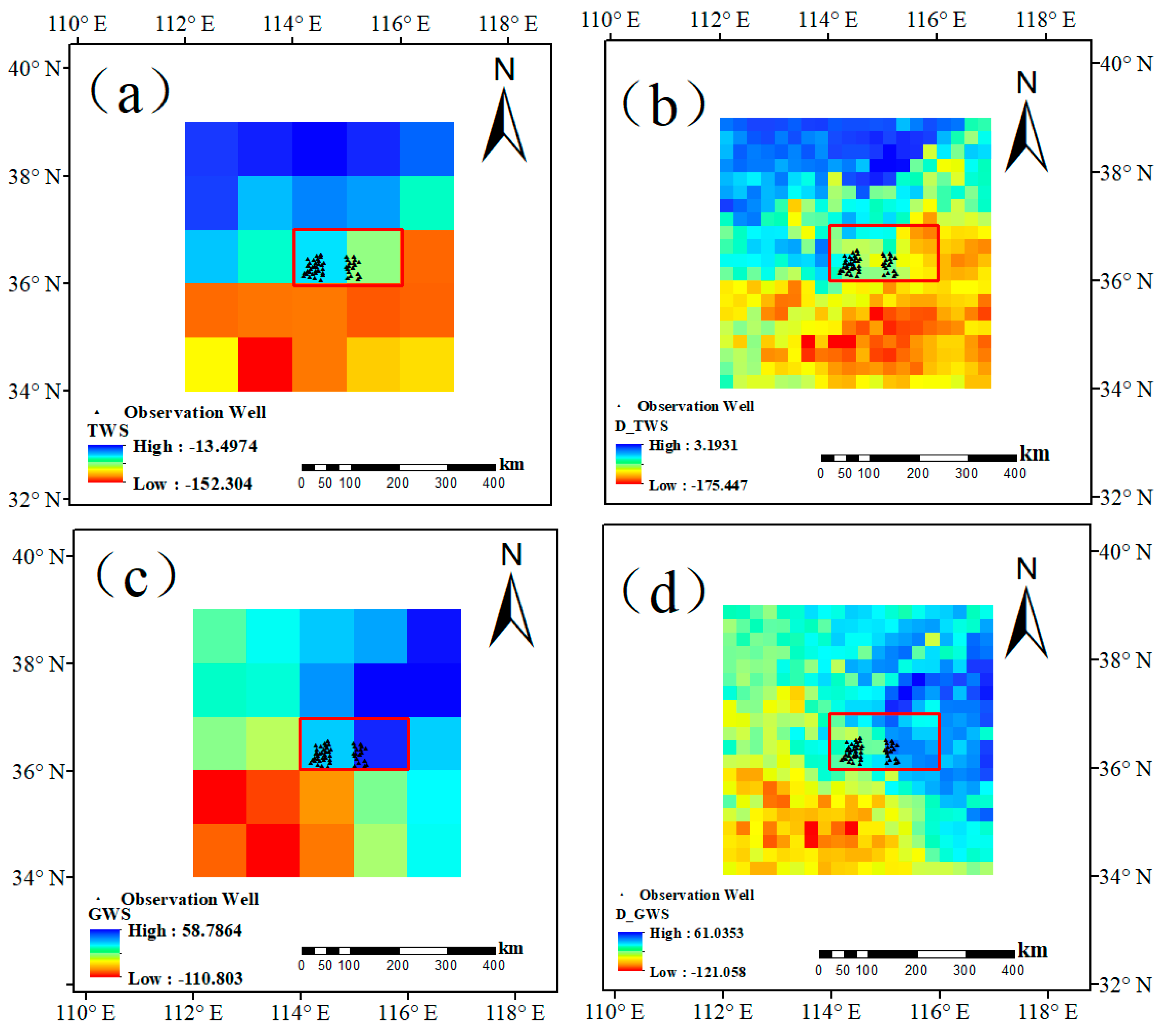
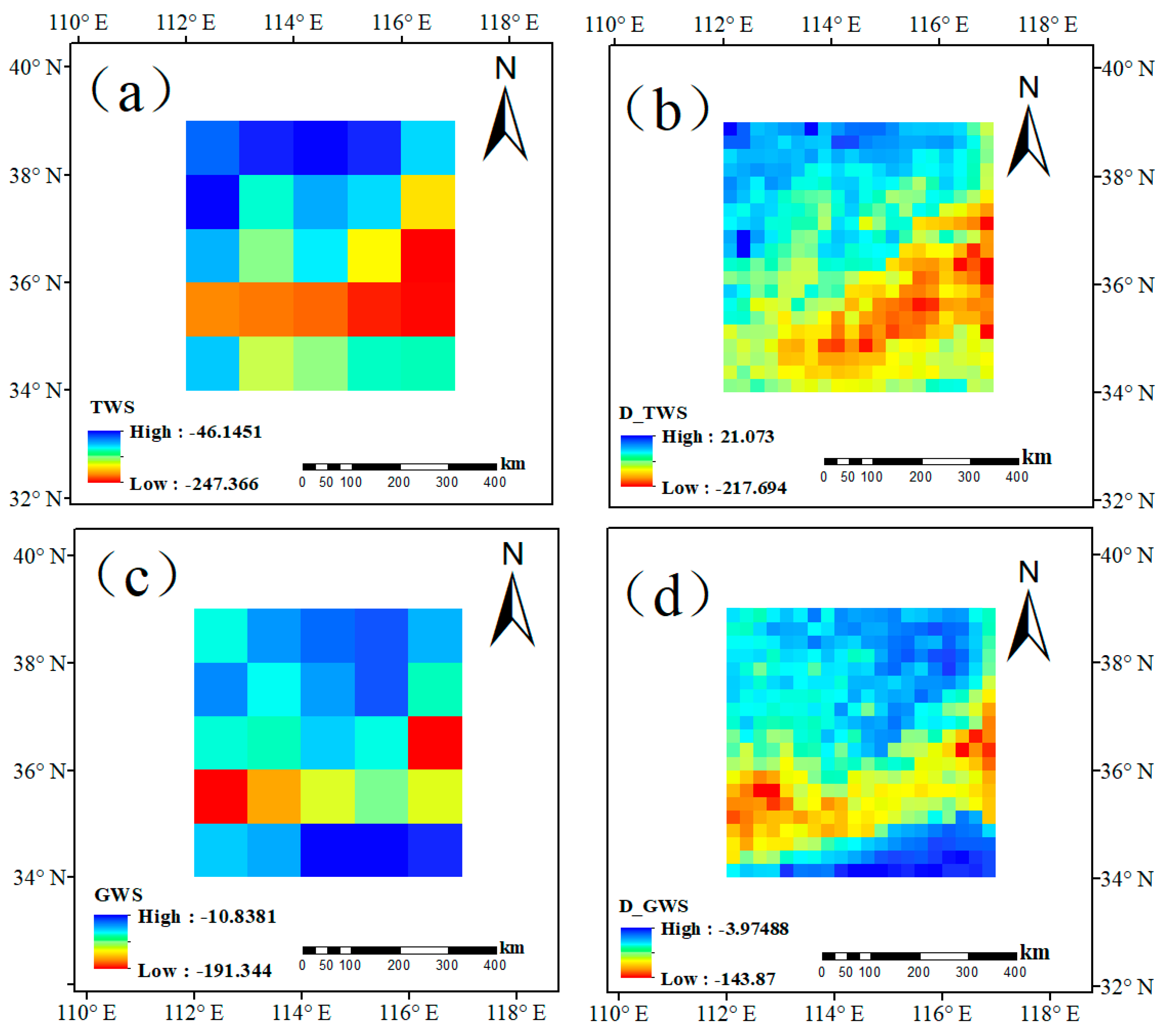
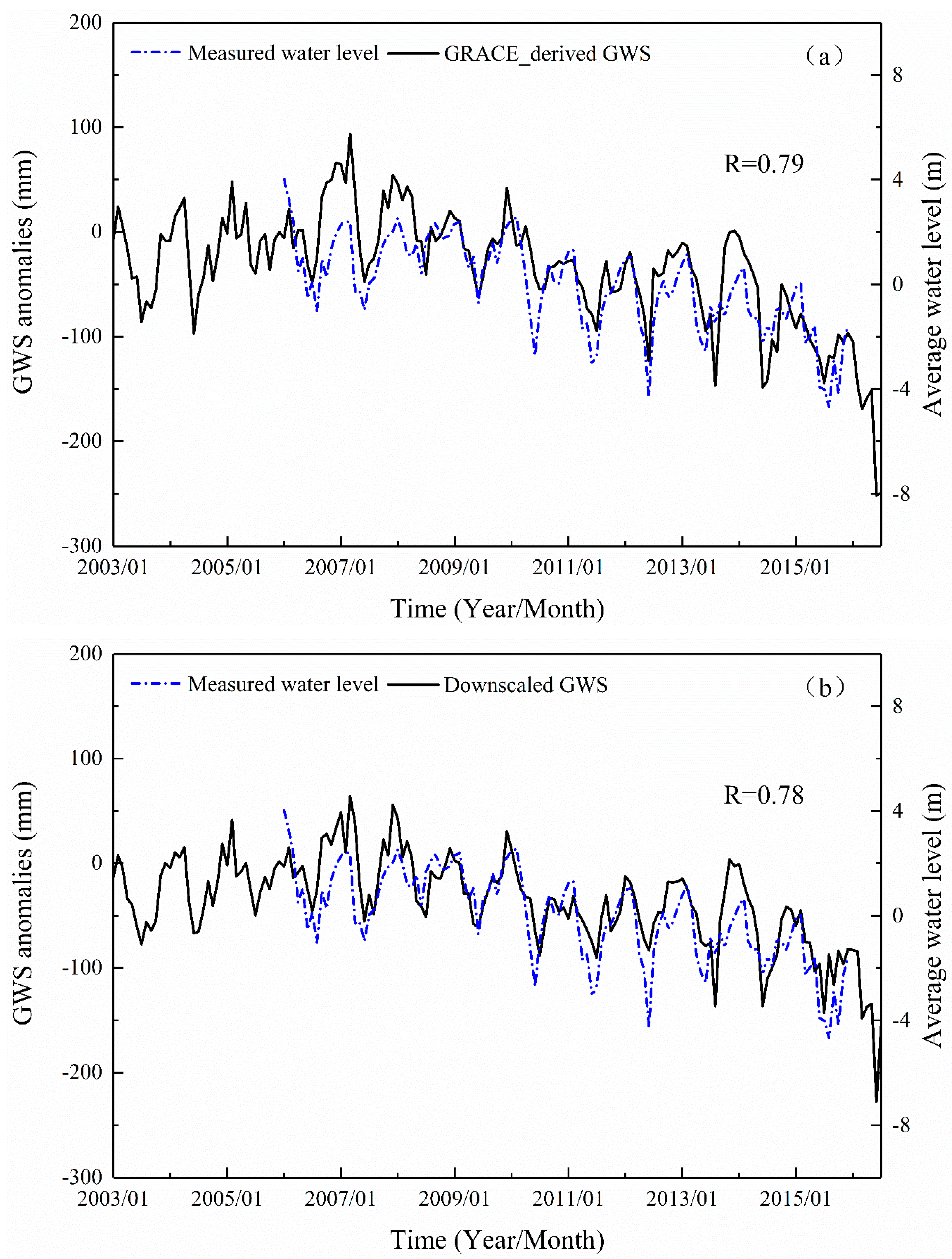

| Models | R | RMSE (mm) | MAE (mm) | NSE |
|---|---|---|---|---|
| RF | 0.83 | 53.75 | 38.97 | 0.68 |
| SVR | 0.78 | 62.40 | 44.83 | 0.57 |
| ANN | 0.81 | 55.74 | 41.23 | 0.66 |
| MLR | 0.78 | 59.93 | 44.84 | 0.61 |
© 2019 by the authors. Licensee MDPI, Basel, Switzerland. This article is an open access article distributed under the terms and conditions of the Creative Commons Attribution (CC BY) license (http://creativecommons.org/licenses/by/4.0/).
Share and Cite
Chen, L.; He, Q.; Liu, K.; Li, J.; Jing, C. Downscaling of GRACE-Derived Groundwater Storage Based on the Random Forest Model. Remote Sens. 2019, 11, 2979. https://doi.org/10.3390/rs11242979
Chen L, He Q, Liu K, Li J, Jing C. Downscaling of GRACE-Derived Groundwater Storage Based on the Random Forest Model. Remote Sensing. 2019; 11(24):2979. https://doi.org/10.3390/rs11242979
Chicago/Turabian StyleChen, Li, Qisheng He, Kun Liu, Jinyang Li, and Chenlin Jing. 2019. "Downscaling of GRACE-Derived Groundwater Storage Based on the Random Forest Model" Remote Sensing 11, no. 24: 2979. https://doi.org/10.3390/rs11242979
APA StyleChen, L., He, Q., Liu, K., Li, J., & Jing, C. (2019). Downscaling of GRACE-Derived Groundwater Storage Based on the Random Forest Model. Remote Sensing, 11(24), 2979. https://doi.org/10.3390/rs11242979





